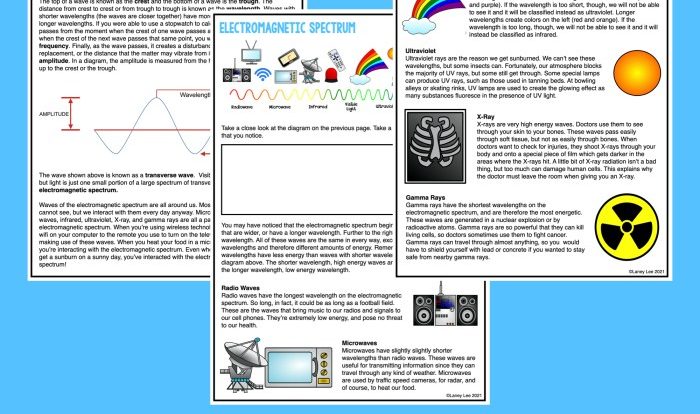Embark on a captivating journey into the realm of light and prisms, where we unravel the secrets of how light interacts with these multifaceted wonders. From the mesmerizing colors of a rainbow to the scientific marvels of spectroscopy, prepare to be enlightened by the illuminating power of light thru a prism crossword clue.
As light traverses the crystalline structure of a prism, it undergoes a mesmerizing transformation, revealing the hidden spectrum of colors that make up our world. This phenomenon, known as dispersion, holds the key to understanding the rainbow’s vibrant hues and the groundbreaking applications of prisms in scientific research.
Explain the concept of light passing through a prism.
A prism is a transparent object with polished, flat surfaces that refract light. When light passes through a prism, it is bent, or refracted. This is because the speed of light is different in different materials. Light travels slower in glass than it does in air.
When light enters a prism from air, it slows down and bends towards the normal (a perpendicular line to the surface at the point of incidence). When light exits the prism into air, it speeds up and bends away from the normal.
The amount that light is bent depends on its wavelength. Shorter wavelengths (blue light) are bent more than longer wavelengths (red light). This is because shorter wavelengths have more energy than longer wavelengths. As a result, when white light passes through a prism, it is separated into its component colors.
This is called dispersion.
The following diagram shows how light passes through a prism:
+-------------------+
| |
| |
| |
| |
| |
| |
| |
| |
+-------------------+
\ /
\ /
\ /
\ /
\ /
\ /
\ /
\/
The light enters the prism from the left and is refracted towards the normal.
It then strikes the back surface of the prism and is refracted again, this time away from the normal. The light then exits the prism and is dispersed into its component colors.
Discuss the phenomenon of dispersion.
Dispersion is a phenomenon that occurs when light passes through a prism. It causes the light to be separated into its component colors, creating a rainbow effect. This happens because the different colors of light have different wavelengths, and they are refracted (bent) by the prism at different angles.
The shorter the wavelength of light, the more it is refracted. This means that violet light, which has the shortest wavelength, is refracted the most, while red light, which has the longest wavelength, is refracted the least. As a result, the colors of light are separated into a spectrum, with violet at one end and red at the other.
Examples of dispersion in everyday life
Dispersion can be seen in a variety of everyday situations. For example, it is what causes the rainbow to form. When sunlight passes through raindrops, it is dispersed into its component colors, creating the familiar rainbow pattern. Dispersion is also responsible for the colors seen in soap bubbles and oil slicks.
Describe the formation of a rainbow.: Light Thru A Prism Crossword Clue
Rainbows are caused by a combination of sunlight and water droplets in the atmosphere. When sunlight passes through a water droplet, it is refracted, or bent. The different colors of light are refracted at different angles, so the light is separated into a rainbow.
Role of water droplets and sunlight in rainbow formation.
For a rainbow to form, the sun must be behind the observer and the water droplets must be in front of the observer. The sun’s rays must also be at a low angle to the horizon, so that the light can be refracted by the water droplets.
Detailed illustration of rainbow formation., Light thru a prism crossword clue
The following is a detailed illustration of how a rainbow is formed:
- Sunlight passes through a water droplet.
- The light is refracted, or bent, as it passes through the water droplet.
- The different colors of light are refracted at different angles, so the light is separated into a rainbow.
- The rainbow is visible to the observer because the light is reflected back to the observer’s eyes.
The colors of the rainbow are always in the same order: red, orange, yellow, green, blue, indigo, and violet. The red light is refracted the least, and the violet light is refracted the most.
Discuss the use of prisms in spectroscopy.
Prisms are valuable tools in spectroscopy, a technique used to analyze the composition of substances based on their absorption or emission of light. Prisms help separate light into its component wavelengths, enabling scientists to identify and quantify the elements and molecules present in a sample.
Types of Spectroscopy Utilizing Prisms
There are several types of spectroscopy that employ prisms:
-
-*Emission spectroscopy
Analyzes the wavelengths of light emitted by a sample when it is heated or excited.
-*Absorption spectroscopy
Examines the wavelengths of light absorbed by a sample when a beam of light is passed through it.
-*Fluorescence spectroscopy
Measures the wavelengths of light emitted by a sample after it has absorbed light of a specific wavelength.
Question Bank
What is the phenomenon responsible for the separation of colors when light passes through a prism?
Dispersion
How are prisms used in spectroscopy?
To separate light into its component wavelengths
What is the role of water droplets in rainbow formation?
They act as miniature prisms, dispersing sunlight into a rainbow

